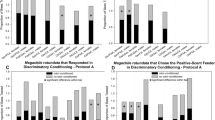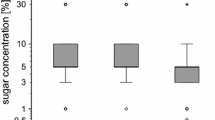Abstract
To understand the effect of abnormal brood odors on the initiation or control of hygienic behavior in honey bees, we employed the associative learning paradigm, proboscis extension reflex conditioning. Bees from two genetic lines(hygienic and non-hygienic) were able to discriminate between high concentrations of two floral odors equally well. Differential discrimination abilities were observed between the two lines when healthy and diseased brood odors were used, with the bees from the hygienic line discriminating between the pair of brood odors better than the non-hygienic bees. These results suggest that hygienic behavior in individual bees is associated with the bees' responses to olfactory stimuli emanating from diseased brood.
Similar content being viewed by others
REFERENCES
Arathi, H. S., Burns, I., and Spivak, M. (2000). Ethology of hygienic behaviour in the honey bee Apis mellifera L. (Hymenoptera: Apidae): behavioural repertoire of hygienic bees. Ethology 106: in press.
Benatar, S., Cobey, S., and Smith, B. H. (1995). Selection on a haploid genotype for discrimination learning performance: correlation between drone honey bees (Apis mellifera) and their worker progeny (Hymenoptera: Apidae) J. Insect Behav. 8: 637-652.
Bhagavan, S., Benatar, S., Cobey, S., and Smith, B. H. (1994). Effect of genotype but not of age or caste on olfactory learning performance in the honey bee, Apis mellifera. Anim. Behav. 48: 1357-1369.
Bhagavan, S., and Smith, B. H. (1997). Olfactory conditioning in the honey bee, Apis mellifera: Effects of CS intensity. Physiol. Behav. 61(1): 107-117.
Boecking, O., and Drescher, W. (1992). The removal response of Apis mellifera L. colonies towards sealed brood cells infested with Varroa jacobsoni: techniques, extent and efficacy. Apidologie 23: 371-373.
Gilliam, M., Taber, S. III, and Richardson, G. V. (1983). Hygienic behavior of honey bees in relation to chalkbrood disease. Apidologie 14: 29-39.
Jay, S. C. (1962). Colour changes in honeybee pupae. Bee World 43(4): 119-122.
Kravitz, E. A. (1988). Hormonal control of behavior: amines and the biasing of behavioral output in lobsters. Science. 241(4874): 1775-1781.
Momot, J. P., and Rothenbuhler, W. C. (1971). Behaviour genetics of nest cleaning in honey bees. VI. Interactions of age and genotype of bees, and nectar flow. J. Apic. Res. 10: 11-21.
Moritz R. F. A. (1988). A reevaluation of the two-locus model for hygienic behavior in honey bees (Apis mellifera L.) J. Heredity 79(4): 257-262.
Peng, Y. S., Fang, Y., Xu, S., Ge, L., and Nasr, M. E. (1987). Reponse of foster Asian honey bee (Apis cerana Fabr.) colonies to the brood of European honey bee (Apis mellifera L.) infested with parasitic mite Varroa jacobsoni Oudemanns. J. Invert. Path. 49: 259-264.
Rothenbuhler, W. C. (1964). Behaviour genetics of nest cleaning in honey bees. IV. Responses of F1 and backcross generations to disease-killed. Am. Zoologist 4: 111-123.
SAS Institute Inc., SAS/STAT* User's Guide, Version 6, Fourth Edition, Volume 1, Cary, NC: SAS Institute Inc., 1989, pp. 405-518.
Spivak, M. (1996). Honey bee hygienic behavior and defense against Varroa jacobsoni. Apidologie 27: 245-260.
Spivak, M., and Downey, D. (1998). Field assays for hygienic behavior in honey bees (Apidae: Hymenoptera). J. Econ. Ent. 91: 64-70.
Spivak, M., and Gilliam, M. (1993). Facultative expression of hygienic behavior in relation to disease resistance. J. Apic. Res. 32: 147-157.
Spivak, M., and Gilliam, M. (1998a). Hygienic behaviour of honey bees and its application for control of brood diseases and varroa Part I. Hygienic behaviour and resistance to American foulbrood. Bee World 79(3): 124-134.
Spivak, M., and Gilliam, M. (1998b). Hygienic behaviour of honey bees and its application for control of brood diseases and varroa Part II. Studies on hygienic behaviour since theRothenbuhler era. Bee World 79(4): 169-186.
Thompson, V. C. (1964). Behaviour genetics of nest cleaning in honey bees. III. Effect of age of bees of a resistant line on their response to disease-killed brood. J. Apic. Res. 3: 25-30.
Trump, R. F., Thompson, V. C., and Rothenbuhler, W. C. (1967). Behaviour genetics of nest cleaning in honey bees. V. Effect of previous experience and composition of mixed colonies on response to disease-killed brood. J. Apic. Res. 6: 127-131.
Wilson, E. O. (1985). The sociogenesis of insect colonies. Science 228: 1489-1495.
Woodrow, A. W., and Holst, E. C. (1942). The mechanism of colony resistance to American foulbrood. J. Econ. Ent. 35: 327-330.
Author information
Authors and Affiliations
Rights and permissions
About this article
Cite this article
Masterman, R., Smith, B.H. & Spivak, M. Brood Odor Discrimination Abilities in Hygienic Honey Bees (Apis mellifera L.) Using Proboscis Extension Reflex Conditioning. Journal of Insect Behavior 13, 87–101 (2000). https://doi.org/10.1023/A:1007767626594
Issue Date:
DOI: https://doi.org/10.1023/A:1007767626594




